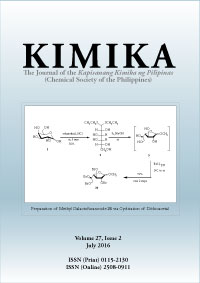Content Analysis of the Discussion of the Atom in General Chemistry Textbooks Using Evaluation Criteria Based on the Nature of Science and Philosophy of Chemistry
DOI:
https://doi.org/10.26534/kimika.v27i2.50-62Keywords:
History and Philosophy of Science, Philosophy of Chemistry, Nature of Science, Chemistry Education, Textbook Analysis, General ChemistryAbstract
Evaluation criteria are adapted from previous textbook analyses on the nature of science (NOS) in general chemistry textbooks. These criteria are used to determine how certain NOS dimensions are mentioned and elaborated in those textbooks. Such dimensions emphasize that chemistry is (1) tentative, (2) empirical, (3) model-based, (4) inferential, (5) has technological products, (6) employs instrumentation, and (7) possesses social and societal dimensions. Three book chapters were read and evaluated: the first (on chemistry in general); the second (on atomic structure); and the sixth or seventh chapters (on the electronic structure of atoms). The relevant content in each textbook were rated using the following rubric: Satisfactory and Explicit (S, 2 points); Mention and Implicit (M, 1 point); and No Mention (N, 0 point). Silberberg (2009) has the highest score among the six textbooks with 12 points out of the maximum of 14. It was rated S for five criteria, the most among the six textbooks. Despite the presence of some N evaluations, all textbooks have mentioned some or all of the NOS dimensions formulated, resulting to M and S ratings. This study concludes that NOS dimensions are already present in various ways and varying degrees in each textbook.Downloads
Published
2017-02-08
How to Cite
Perez, A. J. E., Guidote, A. J. M., Yu, G. U., & Mariano, M. N. E. (2017). Content Analysis of the Discussion of the Atom in General Chemistry Textbooks Using Evaluation Criteria Based on the Nature of Science and Philosophy of Chemistry. KIMIKA, 27(2), 50–62. https://doi.org/10.26534/kimika.v27i2.50-62
Issue
Section
Research Articles
License
Authors who publish with this journal agree to the following terms:
- Authors retain copyright and grant the journal right of first publication with the work simultaneously licensed under a Creative Commons Attribution License that allows others to share the work with an acknowledgement of the work's authorship and initial publication in this journal.
- Authors are able to enter into separate, additional contractual arrangements for the non-exclusive distribution of the journal's published version of the work (e.g., post it to an institutional repository or publish it in a book), with an acknowledgement of its initial publication in this journal.
- Authors are permitted and encouraged to post their work online (e.g., in institutional repositories or on their website) prior to and during the submission process, as it can lead to productive exchanges, as well as earlier and greater citation of published work (See The Effect of Open Access).





